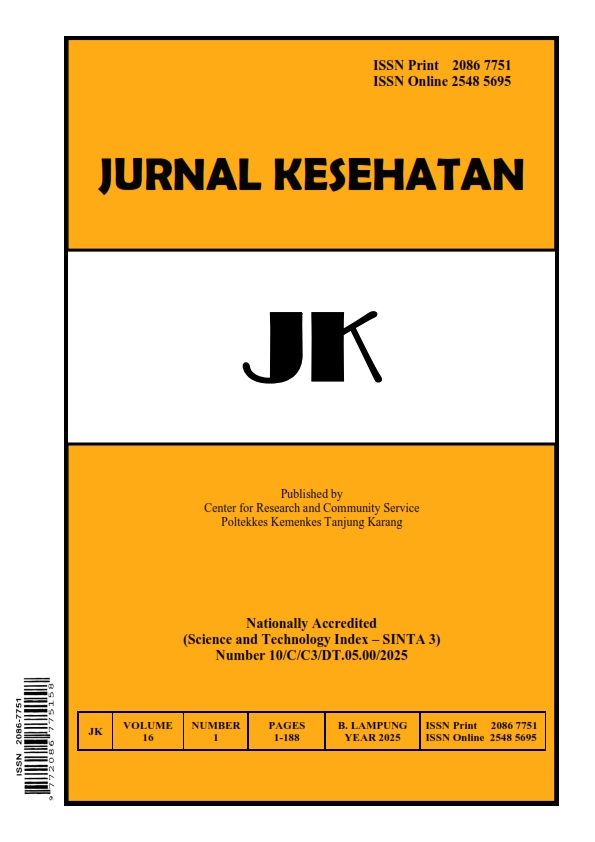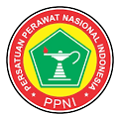The Relationship of Working Period and Awards with The Caring Behavior of Nurses
DOI:
https://doi.org/10.26630/jk.v16i1.4921Keywords:
Caring nurses, Nurses awards, Working periodAbstract
Caring behavior involves actions rooted in concern, compassion, skill, empathy, responsibility, sensitivity, and support. Previous studies have indicated that many nurses do not exhibit caring behavior, which is influenced by various factors. Research at RSUD Abdul Moeloek revealed that care was primarily focused on physical ailments, with limited nurse presence and inadequate psychological support for patients. Among the 10 respondents, 75% noted that nurses did not display caring behaviors, such as presence, touch, listening, and understanding, while 25% did. This study aims to examine the relationship between work experience and awards with the caring behavior of nurses in the Internal Medicine ward at RSUD Dr. H. Abdul Moeloek, Lampung. Conducted from March to April 2024, this quantitative research used a descriptive-analytic design with a cross-sectional approach. A total of 33 respondents were selected through total sampling. Data were collected using questionnaires completed by respondents and researchers. The relationship between independent and dependent variables was tested using the Chi-square test, with univariate and bivariate analysis. Results showed a significant relationship between work experience (p-value=0.007, OR=19.429) and awards (p-value=0.003, OR=13.750) and nurses' caring behavior. It is recommended that the hospital enhance service quality, especially through training, to improve nurses' caring and friendliness towards patients.
References
Anggoro, W. T., Aeni, Q., & Istioningsih, I. (2019). Hubungan karakteristik perawat dengan perilaku caring. Jurnal Keperawatan Jiwa, 6(2), 98-105. https://doi.org/10.26714/jkj.6.2.2018.98-105
Aprina. (2023). Buku Ajar Metodologi Penelitian Keperawatan. Bandar Lampung.
Faizin, A., & Ambarwati, W. N. (2008). Hubungan Tingkat Pendidikan dan Lama Kerja Perawat dengan Kinerja Perawat di RSU Pandan Arang Kabupaten Boyolali. Jurnal Berita Ilmu Keperawatan, 1(3), 137-142. https://journals.ums.ac.id/BIK/article/view/3750/2419
Kuntarti, K., Yetti, K., & Novieastari, E. (2018). The contributing individuals in developing caring behaviors of nursing students: The focus group finding. International Journal for Human Caring, 22(4), 169–178. https://doi.org/10.20467/1091-5710.22.4.169
Kusnanto. (2019). Perilaku caring perawat profesional. Surabaya: Airlangga University Publishing and Printing Center (AUP).
Manurung, S., & Hutasoit, M. L. C. (2013). Persepsi Pasien Terhadap Perilaku Caring Perawat di Ruang Rawat Inap Rumah Sakit. Kesmas: National Public Health Journal, 8(3), 104. https://doi.org/10.21109/kesmas.v8i3.351
Meidiana, D. (2007). Caring: The Key to Success for Nurses to Practice Knowledge. Cirebon: Hasani.
Morrison, P., Burnard, P. (2019). Caring & communicating: interpersonal relationships in nursing, (Ed.2). Jakarta: EGC.
Nangoi, W. J., Pondaag, L., & Hamel, R. (2014). Hubungan Pemberian Reward dengan Kinerja Perawat di Ruangan IRINA A RSUP Prof. DR. RD Kandou Manado. Jurnal Keperawatan UNSRAT, 2(2), 109066. https://ejournal.unsrat.ac.id/index.php/jkp/article/view/5276
Notoatmodjo. (2018). Human Resource Development. Jakarta: Rineka Cipta.
Nurwianti, I., Mita, & Putri, T. H. (2020). Caring Behavior of Nurses on Patient Satisfaction Levels in Hospitals: Literature Review. Proners Journal, 5(2),19. https://jurnal.untan.ac.id/index.php/jmkeperawatanFK/article/view/46161
Purwaningsih, D. F. (2018). Perilaku caring perawat pelaksana di ruang rawat inap. Jurnal Ilmiah Kesehatan, 9(1), 61-67. https://ojs.unsiq.ac.id/index.php/jik/article/view/152
Purnamasari, N., & Putri Utami, D. (2020). Hubungan Komunikasi Terapeutik Perawat Dengan Kepuasan Pasien Di Ruang Rawat Inap Kelas II dan III RSUD Wonosari Yogyakarta the Correlation Between Nursing Therapeutic Communication With Patient Satisfaction in Patient Room of Class Ii and Iii in Wonosari. Jurnal Kesehatan Samodra Ilmu, 10(1), 19-35.
Septiani, L. D. (2021). Hubungan Beban Kerja Perawat Dengan Perilaku Caring Perawat Pada Masa Pandemi Covid-19 Di Rumah Sakit Umum Daerah Koja. [Undergraduate thesis]. Jakarta: Universitas Pembangunan Nasional Veteran Jakarta.
Sangkala, F., Irwan, A. M., & Tahir, T. (2018). Uji Validitas Dan Reabilitas Caring Behaviors Inventory (CBI) Di Beberapa Negara: Literature Review. Jurnal Keperawatan Muhammadiyah, 3(2). https://doi.org/10.30651/jkm.v3i2.1816
Saputra, D., Nurlina, N., & Hasan, L. (2017). Pengaruh reward dan punishment terhadap produktivitas kerja karyawan PT. Kereta Api Indonesia (persero) divisi regional II Sumatera Barat. Manajemen dan Kewirausahaan, 8(1), 53-66. https://doi.org/10.31227/osf.io/wz5xe
Samsualam, S. (2023). Buku Referensi: Keperawatan Holistik. Purbalingga: Eureka Media Aksara.
Setyowati, N., & Quyumi, E. (2018). Gambaran sikap caring mahasiswa keperawatan yang telah menjalani praktik klinik di rumah sakit. Jurnal Ilmu Kesehatan Vol, 6(2). http://ejurnaladhkdr.com/index.php/jik/article/view/175
Sutria, E., & Azhar, M. U. (2017). Faktor-faktor yang berhubungan dengan perilaku caring perawat di ruang perawatan interna. Journal of islamic nursing, 2(2), 82-92. https://journal3.uin-alauddin.ac.id/index.php/join/article/view/3977
Watson, J. (2002). Intentionality and caring-healing X is a different way of being human, consciousness. A practice of transpersonal nursing. Holistic Nursing Practice, 16(4), 12-19. https://doi.org/10.1097/00004650-200207000-00005
Downloads
Published
Issue
Section
License
Copyright (c) 2025 Siti Dwi Yunita, Aprina Aprina, Sunarsih Sunarsih

This work is licensed under a Creative Commons Attribution-ShareAlike 4.0 International License.
Authors who publish in this journal agree to the following terms:
- Authors retain copyright and grant the journal right of first publication with the work simultaneously licensed under a Creative Commons Attribution License (CC BY-SA 4.0) that allows others to share the work with an acknowledgment of the work's authorship and initial publication in this journal.
- Authors can enter into separate, additional contractual arrangements for the non-exclusive distribution of the journal's published version of the work (e.g., post it to an institutional repository or publish it in a book), with an acknowledgment of its initial publication in this journal.
- Authors are permitted and encouraged to post their work online (e.g., in institutional repositories or on their website) prior to and during the submission process, as this can lead to productive exchanges and earlier and greater citations of published work.












